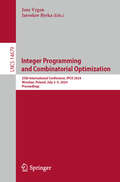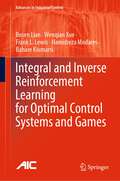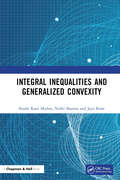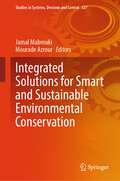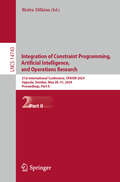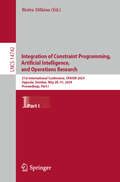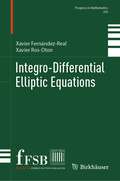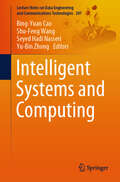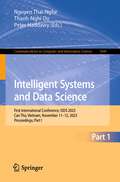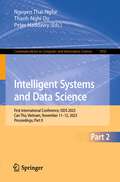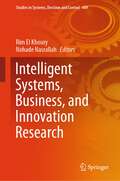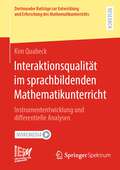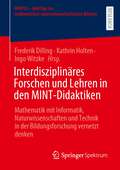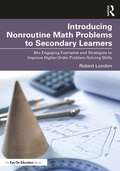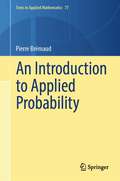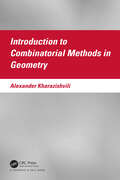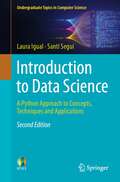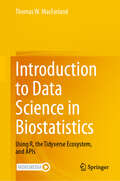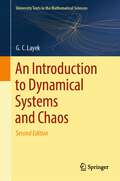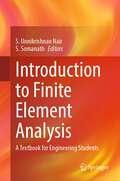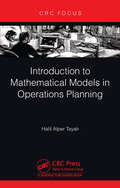- Table View
- List View
Integer Programming and Combinatorial Optimization: 25th International Conference, IPCO 2024, Wroclaw, Poland, July 3–5, 2024, Proceedings (Lecture Notes in Computer Science #14679)
by Jens Vygen Jarosław ByrkaThis book constitutes the refereed proceedings of the 25th International Conference on Integer Programming and Combinatorial Optimization, IPCO 2024, held in Wrocław, Poland, during July 3–5, 2024. The 33 full papers presented were carefully reviewed and selected from 101 submissions. IPCO is under the auspices of the Mathematical Optimization Society, and it is an important forum for presenting present recent developments in theory, computation, and applications. The scope of IPCO is viewed in a broad sense, to include algorithmic and structural results in integer programming and combinatorial optimization as well as revealing computational studies and novel applications of discrete optimization to practical problems.
Integral and Inverse Reinforcement Learning for Optimal Control Systems and Games (Advances in Industrial Control)
by Bosen Lian Wenqian Xue Frank L. Lewis Hamidreza Modares Bahare KiumarsiIntegral and Inverse Reinforcement Learning for Optimal Control Systems and Games develops its specific learning techniques, motivated by application to autonomous driving and microgrid systems, with breadth and depth: integral reinforcement learning (RL) achieves model-free control without system estimation compared with system identification methods and their inevitable estimation errors; novel inverse RL methods fill a gap that will help them to attract readers interested in finding data-driven model-free solutions for inverse optimization and optimal control, imitation learning and autonomous driving among other areas. Graduate students will find that this book offers a thorough introduction to integral and inverse RL for feedback control related to optimal regulation and tracking, disturbance rejection, and multiplayer and multiagent systems. For researchers, it provides a combination of theoretical analysis, rigorous algorithms, and a wide-ranging selection of examples. The book equips practitioners working in various domains – aircraft, robotics, power systems, and communication networks among them – with theoretical insights valuable in tackling the real-world challenges they face.
Integral Inequalities and Generalized Convexity
by Shashi Kant Mishra Nidhi Sharma Jaya BishtThe book covers several new research findings in the area of generalized convexity and integral inequalities. Integral inequalities using various type of generalized convex functions are applicable in many branches of mathematics such as mathematical analysis, fractional calculus, and discrete fractional calculus. The book contains integral inequalities of Hermite-Hadamard type, Hermite- Hadamard-Fejer type and majorization type for the generalized strongly convex functions. It presents Hermite-Hadamard type inequalities for functions defined on Time scales. Further, it provides the generalization and extensions of the concept of preinvexity for interval-valued functions and stochastic processes, and give Hermite-Hadamard type and Ostrowski type inequalities for these functions. These integral inequalities are utilized in numerous areas for the boundedness of generalized convex functions. Features: Covers Interval-valued calculus, Time scale calculus, Stochastic processes – all in one single book. Numerous examples to validate results Provides an overview of the current state of integral inequalities and convexity for a much wider audience, including practitioners. Applications of some special means of real numbers are also discussed. The book is ideal for anyone teaching or attending courses in integral inequalities along with researchers in this area.
Integral Inequalities and Generalized Convexity
by Shashi Kant Mishra Nidhi Sharma Jaya BishtThe book covers several new research findings in the area of generalized convexity and integral inequalities. Integral inequalities using various type of generalized convex functions are applicable in many branches of mathematics such as mathematical analysis, fractional calculus, and discrete fractional calculus. The book contains integral inequalities of Hermite-Hadamard type, Hermite- Hadamard-Fejer type and majorization type for the generalized strongly convex functions. It presents Hermite-Hadamard type inequalities for functions defined on Time scales. Further, it provides the generalization and extensions of the concept of preinvexity for interval-valued functions and stochastic processes, and give Hermite-Hadamard type and Ostrowski type inequalities for these functions. These integral inequalities are utilized in numerous areas for the boundedness of generalized convex functions. Features: Covers Interval-valued calculus, Time scale calculus, Stochastic processes – all in one single book. Numerous examples to validate results Provides an overview of the current state of integral inequalities and convexity for a much wider audience, including practitioners. Applications of some special means of real numbers are also discussed. The book is ideal for anyone teaching or attending courses in integral inequalities along with researchers in this area.
Integrated Solutions for Smart and Sustainable Environmental Conservation (Studies in Systems, Decision and Control #527)
by Jamal Mabrouki Mourade AzrourResource depletion and ecological risks are more than ever at the heart of societal and economic debates. In the 1970s, the developed countries saw the Fordist growth regime crumble in parallel with the growing awareness of the ecological issue. Since the first industrial revolutions, technological dynamics have been the cause of many environmental problems, and there is a consensus on the diagnosis. Integrated technologies reduce resource use and/or pollution at source by using cleaner production methods. This generally leads to a reduction in the by-products, energy inputs and resources used by companies to produce goods. Integrated production technologies reduce negative environmental impacts at source by substituting or modifying cleaner technologies. Examples of integrated, or cleaner, production technologies are the recirculation of materials, the use of environmentally friendly materials (such as the substitution of water for organic solvents), etc. However, the implementation of integrated production technologies is often hampered by obstacles related to cost, coordination and skill inertia problems and to the productive organisation of companies. In addition to the high investment costs of new integrated technologies, additional barriers may emerge depending on the nature of the environmental problem and the type of environmental regulation in question.
Integration of Constraint Programming, Artificial Intelligence, and Operations Research: 21st International Conference, CPAIOR 2024, Uppsala, Sweden, May 28–31, 2024, Proceedings, Part II (Lecture Notes in Computer Science #14743)
by Bistra DilkinaThis book constitutes the proceedings of the 21st International Conference on the Integration of Constraint Programming, Artificial Intelligence, and Operations Research, CPAIOR 2024, held in Uppsala, Sweden, during May 28–31, 2024.The 33 full papers and the 9 short papers presented in the proceedings were carefully reviewed and selected from a total of 104 submissions. The content of the papers focus on new techniques or applications in the area and foster the integration of techniques from different fields dealing with large and complex problems.
Integration of Constraint Programming, Artificial Intelligence, and Operations Research: 21st International Conference, CPAIOR 2024, Uppsala, Sweden, May 28–31, 2024, Proceedings, Part I (Lecture Notes in Computer Science #14742)
by Bistra DilkinaThis book constitutes the proceedings of the 21st International Conference on the Integration of Constraint Programming, Artificial Intelligence, and Operations Research, CPAIOR 2024, held in Uppsala, Sweden, during May 28–31, 2024. The 33 full papers and the 9 short papers presented in the proceedings were carefully reviewed and selected from a total of 104 submissions. The content of the papers focus on new techniques or applications in the area and foster the integration of techniques from different fields dealing with large and complex problems.
Integro-Differential Elliptic Equations (Progress in Mathematics #350)
by Xavier Ros-Oton Xavier Fernández-RealThis monograph offers a self-contained introduction to the regularity theory for integro-differential elliptic equations, mostly developed in the 21st century. This class of equations finds relevance in fields such as analysis, probability theory, mathematical physics, and in several contexts in the applied sciences. The work gives a detailed presentation of all the necessary techniques, with a primary focus on the main ideas rather than on proving all the results in their greatest generality. The basic building blocks are presented first, with the study of the square root of the Laplacian, and weak solutions to linear equations. Subsequently, the theory of viscosity solutions to nonlinear equations is developed, and proofs are provided for the main known results in this context. The analysis finishes with the investigation of obstacle problems for integro-differential operators and establishes the regularity of solutions and free boundaries. A distinctive feature of this work lies in its presentation of nearly all covered material in a monographic format for the first time, and several proofs streamline, and often simplify, those in the original papers. Furthermore, various open problems are listed throughout the chapters.
Intelligent Systems and Computing (Lecture Notes on Data Engineering and Communications Technologies #207)
by Bing-Yuan Cao Shu-Feng Wang Seyed Hadi Nasseri Yu-Bin ZhongThis book includes high quality research papers submitted at the 2022 “Four Session (ICFIE, ICORG, GDORS, CGHMORS) Celebration” Joint International Conference held on December 28, 2022 and the online meeting of the Fuzzy Information and Engineering Branch of the China Operations Research Society on September 17, 2022. It covers topics in the fields of certainty, stochastic uncertainty, and fuzzy uncertainty, including computer science and mathematics, operations research and control, artificial intelligence, information and engineering technology, barrier-free communication for people with disabilities, digital logistics and knowledge representation, medical applications, queuing theory and game theory, algorithms and optimization methods. The book is a valuable reference book for scholars, engineers, management professionals, and graduate, undergraduate, and vocational students interested in computer science, mathematics, and fuzzy mathematics and operations research, as well as their applications in information technology and engineering.
Intelligent Systems and Data Science: First International Conference, ISDS 2023, Can Tho, Vietnam, November 11–12, 2023, Proceedings, Part I (Communications in Computer and Information Science #1949)
by Nguyen Thai-Nghe Thanh-Nghi Do Peter HaddawyThis two-volume set constitutes the refereed proceedings of the First International Conference on Intelligent Systems and Data Science, ISDS 2023, held in Can Tho, Vietnam, in November 2023.The 35 full papers and 13 short papers presented were thoroughly reviewed and selected from 123 submissions. They are organized in the following topical sections: applied intelligent systems and data science for agriculture, aquaculture, and biomedicine; big data, IoT, and cloud computing; deep learning and natural language processing; intelligent systems.
Intelligent Systems and Data Science: First International Conference, ISDS 2023, Can Tho, Vietnam, November 11–12, 2023, Proceedings, Part II (Communications in Computer and Information Science #1950)
by Nguyen Thai-Nghe Thanh-Nghi Do Peter HaddawyThis two-volume set constitutes the refereed proceedings of the First International Conference on Intelligent Systems and Data Science, ISDS 2023, held in Can Tho, Vietnam, in November 2023.The 35 full papers and 13 short papers presented were thoroughly reviewed and selected from 123 submissions. They are organized in the following topical sections: applied intelligent systems and data science for agriculture, aquaculture, and biomedicine; big data, IoT, and cloud computing; deep learning and natural language processing; intelligent systems.
Intelligent Systems, Business, and Innovation Research (Studies in Systems, Decision and Control #489)
by Rim El Khoury Nohade NasrallahIntelligent systems research is a multidisciplinary field that focuses on the development of systems that can perceive, reason, and act autonomously. This can include areas such as machine learning, artificial intelligence, natural language processing, and robotics. The goal of intelligent systems research is to develop systems that can understand, learn from, and adapt to their environment, to perform tasks that would typically require human intelligence.Business and innovation research is an interdisciplinary field that examines how organizations can create, develop, and implement new ideas, products, and services. This can include areas such as organizational behaviour, strategic management, and marketing. The goal of business and innovation research is to understand how organizations can foster an environment that encourages creativity and innovation, and how they can develop and implement new ideas in a way that leads to success.Intelligent Systems, Business and Innovation Research is a research area that brings together these two fields to study the use of intelligent systems and technologies in the business context to drive innovation, improve operational efficiency and effectiveness of the organization. The book aims to understand how intelligent systems can be used in business applications, how to design and implement them, how to manage the associated challenges, and how to leverage them to foster innovation, create new business models, and gain competitive advantage. It offers guidance on how to navigate potential conflicts and challenges that may arise during multidisciplinary research in areas such as Industry 4.0, Internet of Things, modern machine learning, software agent applications, and data science. The book focuses on the various fields in which intelligent systems play a critical role in enabling the development of advanced technologies that can perform tasks that would typically require human intelligence. For example, in smart/control systems, intelligent algorithms can be used to optimize the performance of machines and devices, while in cyber security, they can be used to protect networks and data from cyber-attacks. In bioinformatics, intelligent systems can be used to analyse large amounts of biological data, while in virtual reality and robotics, they can be used to create realistic and responsive simulations and automatons. Additionally, the book also highlights the rapidly advancing theoretical foundations of fuzzy sets, mathematical logic, and non-classical logic. These are important theoretical frameworks for the development of intelligent systems, as they provide the foundation for the representation and manipulation of uncertainty, complexity, and imprecision. These theoretical foundations are essential in the development of intelligent systems that can make decisions and perform tasks in uncertain, complex, and dynamic environments.
Interaktionsqualität im sprachbildenden Mathematikunterricht: Instrumententwicklung und differentielle Analysen (Dortmunder Beiträge zur Entwicklung und Erforschung des Mathematikunterrichts #2)
by Kim QuabeckEin reichhaltiger, sprachbildender Mathematikunterricht lässt sich nicht allein durch sorgfältig designte Aufgaben herstellen, denn die fachlichen und sprachlichen Lerngelegenheiten ergeben sich vor allem auch in der Interaktion zwischen Lehrkräften und Lernenden. Diese hohe Relevanz der Interaktionsqualität ist in qualitativen Fallstudien vielfach belegt, doch nach wie vor wird Interaktionsqualität in quantitativen Studien der Unterrichtsqualitätsforschung noch unsystematisch und mit sehr heterogenen Konzeptualisierungen und Operationalisierungen erfasst. In diesem Buch widmet sich die Autorin dieser Forschungslücke, indem ein sehr hoch auflösendes Analyseinstrument für Interaktionsqualität theoriebasiert entwickelt und beforscht wird. Mittels differentieller Analysen wird des Weiteren der Zusammenhang zwischen Lernmilieus und Lernvoraussetzungen für Interaktionsqualität untersucht.
Interdisziplinäres Forschen und Lehren in den MINT-Didaktiken: Mathematik mit Informatik, Naturwissenschaften und Technik in der Bildungsforschung vernetzt denken (MINTUS – Beiträge zur mathematisch-naturwissenschaftlichen Bildung)
by Frederik Dilling Kathrin Holten Ingo WitzkeFachübergreifender und fächerverbindender Unterricht in den MINT-Fächern (Mathematik, Informatik, Naturwissenschaften & Technik) werden seit Langem in Forschung und Bildungspolitik gefordert, aber selten in der unterrichtlichen Praxis umgesetzt. Um einen solchen Unterricht in der Schule zu fördern, ist es wichtig, die aus den MINT-Fachdidaktiken heraus gemeinsam entwickelten Konzepte zugänglich zu machen und Inhaltsfelder mehrperspektivisch zu erschließen.Der vorliegende Band stellt unterschiedliche interdisziplinäre Vorhaben aus den Bereichen Bildungsforschung, Lehrer*innenbildung und Unterrichtsentwicklung mit einem Fokus auf Mathematik vor.
Introducing Nonroutine Math Problems to Secondary Learners: 60+ Engaging Examples and Strategies to Improve Higher-Order Problem-Solving Skills
by Robert LondonOffering secondary math educators an innovative holistic and process-orientated approach for implementing nonroutine problems into their curriculum, this book defines and establishes practical strategies to develop students’ problem-solving skills. The text focuses on the process skills necessary to solve nonroutine problems in mathematics and other subjects, with the goal of making students better problem-solvers both in and outside of the classroom. Chapters present and define a curriculum of over 60 nonroutine problems in mathematics and other content areas, and explore the pedagogy to implement this type of curriculum consistent with the NCTM Standards and Principles to Action. Four different models of implementation are discussed, alongside a structured approach through seven difficulty levels (with examples), to ensure that every student, independent of their mastery of mathematics content, can improve their ability to solve nonroutine problems. It emphasizes to students how to transfer their problem-solving skills to other real-world areas, including increasing ecological awareness, appreciating diversity and addressing significant and meaningful problems in their life, school and community. The curriculum introduced in this book can be included as a component of a traditional four-year academic high school curriculum aligned with the Common Core Mathematical Practices, or as part of a one-year isolated required or elective mathematics course. Based on extensive field-testing this approach has been effective in both traditional mathematics courses and math electives such as a course in Problem-Solving. This book provides the necessary guidance to allow each mathematics teacher to effectively integrate the approach in their classrooms. This book is ideal for secondary mathematics teachers of all levels, as well as teachers of mathematics electives.
Introducing Nonroutine Math Problems to Secondary Learners: 60+ Engaging Examples and Strategies to Improve Higher-Order Problem-Solving Skills
by Robert LondonOffering secondary math educators an innovative holistic and process-orientated approach for implementing nonroutine problems into their curriculum, this book defines and establishes practical strategies to develop students’ problem-solving skills. The text focuses on the process skills necessary to solve nonroutine problems in mathematics and other subjects, with the goal of making students better problem-solvers both in and outside of the classroom. Chapters present and define a curriculum of over 60 nonroutine problems in mathematics and other content areas, and explore the pedagogy to implement this type of curriculum consistent with the NCTM Standards and Principles to Action. Four different models of implementation are discussed, alongside a structured approach through seven difficulty levels (with examples), to ensure that every student, independent of their mastery of mathematics content, can improve their ability to solve nonroutine problems. It emphasizes to students how to transfer their problem-solving skills to other real-world areas, including increasing ecological awareness, appreciating diversity and addressing significant and meaningful problems in their life, school and community. The curriculum introduced in this book can be included as a component of a traditional four-year academic high school curriculum aligned with the Common Core Mathematical Practices, or as part of a one-year isolated required or elective mathematics course. Based on extensive field-testing this approach has been effective in both traditional mathematics courses and math electives such as a course in Problem-Solving. This book provides the necessary guidance to allow each mathematics teacher to effectively integrate the approach in their classrooms. This book is ideal for secondary mathematics teachers of all levels, as well as teachers of mathematics electives.
An Introduction to Applied Probability (Texts in Applied Mathematics #77)
by Pierre BrémaudThis book provides the elements of probability and stochastic processes of direct interest to the applied sciences where probabilistic models play an important role, most notably in the information and communications sciences, computer sciences, operations research, and electrical engineering, but also in fields like epidemiology, biology, ecology, physics, and the earth sciences.The theoretical tools are presented gradually, not deterring the readers with a wall of technicalities before they have the opportunity to understand their relevance in simple situations. In particular, the use of the so-called modern integration theory (the Lebesgue integral) is postponed until the fifth chapter, where it is reviewed in sufficient detail for a rigorous treatment of the topics of interest in the various domains of application listed above.The treatment, while mathematical, maintains a balance between depth and accessibility that is suitable for theefficient manipulation, based on solid theoretical foundations, of the four most important and ubiquitous categories of probabilistic models:Markov chains, which are omnipresent and versatile models in applied probabilityPoisson processes (on the line and in space), occurring in a range of applications from ecology to queuing and mobile communications networksBrownian motion, which models fluctuations in the stock market and the "white noise" of physicsWide-sense stationary processes, of special importance in signal analysis and design, as well as in the earth sciences.This book can be used as a text in various ways and at different levels of study. Essentially, it provides the material for a two-semester graduate course on probability and stochastic processes in a department of applied mathematics or for students in departments where stochastic models play an essential role. The progressive introduction of concepts and tools, along with the inclusion of numerous examples, also makes this book well-adapted for self-study.
Introduction to Combinatorial Methods in Geometry
by Alexander KharazishviliThis book offers an introduction to some combinatorial (also, set-theoretical) approaches and methods in geometry of the Euclidean space Rm. The topics discussed in the manuscript are due to the field of combinatorial and convex geometry. The author’s primary intention is to discuss those themes of Euclidean geometry which might be of interest to a sufficiently wide audience of potential readers. Accordingly, the material is explained in a simple and elementary form completely accessible to the college and university students. At the same time, the author reveals profound interactions between various facts and statements from different areas of mathematics: the theory of convex sets, finite and infinite combinatorics, graph theory, measure theory, classical number theory, etc. All chapters (and also the five Appendices) end with a number of exercises. These provide the reader with some additional information about topics considered in the main text of this book. Naturally, the exercises vary in their difficulty. Among them there are almost trivial, standard, nontrivial, rather difficult, and difficult. As a rule, more difficult exercises are marked by asterisks and are provided with necessary hints.The material presented is based on the lecture course given by the author. The choice of material serves to demonstrate the unity of mathematics and variety of unexpected interrelations between distinct mathematical branches.
Introduction to Combinatorial Methods in Geometry
by Alexander KharazishviliThis book offers an introduction to some combinatorial (also, set-theoretical) approaches and methods in geometry of the Euclidean space Rm. The topics discussed in the manuscript are due to the field of combinatorial and convex geometry. The author’s primary intention is to discuss those themes of Euclidean geometry which might be of interest to a sufficiently wide audience of potential readers. Accordingly, the material is explained in a simple and elementary form completely accessible to the college and university students. At the same time, the author reveals profound interactions between various facts and statements from different areas of mathematics: the theory of convex sets, finite and infinite combinatorics, graph theory, measure theory, classical number theory, etc. All chapters (and also the five Appendices) end with a number of exercises. These provide the reader with some additional information about topics considered in the main text of this book. Naturally, the exercises vary in their difficulty. Among them there are almost trivial, standard, nontrivial, rather difficult, and difficult. As a rule, more difficult exercises are marked by asterisks and are provided with necessary hints.The material presented is based on the lecture course given by the author. The choice of material serves to demonstrate the unity of mathematics and variety of unexpected interrelations between distinct mathematical branches.
Introduction to Data Science: A Python Approach to Concepts, Techniques and Applications (Undergraduate Topics in Computer Science)
by Laura Igual Santi SeguíThis accessible and classroom-tested textbook/reference presents an introduction to the fundamentals of the interdisciplinary field of data science. The coverage spans key concepts from statistics, machine/deep learning and responsible data science, useful techniques for network analysis and natural language processing, and practical applications of data science such as recommender systems or sentiment analysis. Topics and features: Provides numerous practical case studies using real-world data throughout the book Supports understanding through hands-on experience of solving data science problems using Python Describes concepts, techniques and tools for statistical analysis, machine learning, graph analysis, natural language processing, deep learning and responsible data scienceReviews a range of applications of data science, including recommender systems and sentiment analysis of text data Provides supplementary code resources and data at an associated website This practically-focused textbook provides an ideal introduction to the field for upper-tier undergraduate and beginning graduate students from computer science, mathematics, statistics, and other technical disciplines. The work is also eminently suitable for professionals on continuous education short courses, and to researchers following self-study courses.
Introduction to Data Science in Biostatistics: Using R, the Tidyverse Ecosystem, and APIs
by Thomas W. MacFarlandIntroduction to Data Science in Biostatistics: Using R, the Tidyverse Ecosystem, and APIs defines and explores the term "data science" and discusses the many professional skills and competencies affiliated with the industry. With data science being a leading indicator of interest in STEM fields, the text also investigates this ongoing growth of demand in these spaces, with the goal of providing readers who are entering the professional world with foundational knowledge of required skills, job trends, and salary expectations. The text provides a historical overview of computing and the field's progression to R as it exists today, including the multitude of packages and functions associated with both Base R and the tidyverse ecosystem. Readers will learn how to use R to work with real data, as well as how to communicate results to external stakeholders. A distinguishing feature of this text is its emphasis on the emerging use of APIs to obtain data.
An Introduction to Dynamical Systems and Chaos (University Texts in the Mathematical Sciences)
by G. C. LayekThis book discusses continuous and discrete nonlinear systems in systematic and sequential approaches. The unique feature of the book is its mathematical theories on flow bifurcations, nonlinear oscillations, Lie symmetry analysis of nonlinear systems, chaos theory, routes to chaos and multistable coexisting attractors. The logically structured content and sequential orientation provide readers with a global overview of the topic. A systematic mathematical approach has been adopted, featuring a multitude of detailed worked-out examples alongside comprehensive exercises. The book is useful for courses in dynamical systems and chaos and nonlinear dynamics for advanced undergraduate, graduate and research students in mathematics, physics and engineering. The second edition of the book is thoroughly revised and includes several new topics: center manifold reduction, quasi-periodic oscillations, Bogdanov–Takens, period-bubbling and Neimark–Sacker bifurcations, and dynamics on circle. The organized structures in bi-parameter plane for transitional and chaotic regimes are new active research interest and explored thoroughly. The connections of complex chaotic attractors with fractals cascades are explored in many physical systems. Chaotic attractors may attain multiple scaling factors and show scale invariance property. Finally, the ideas of multifractals and global spectrum for quantifying inhomogeneous chaotic attractors are discussed.
Introduction to Finite Element Analysis: A Textbook for Engineering Students
by S. Unnikrishnan Nair S. SomanathThis textbook covers the basic concepts and applications of finite element analysis. It is specifically aimed at introducing this advanced topic to undergraduate-level engineering students and practicing engineers in a lucid manner. It also introduces a structural and heat transfer analysis software FEASTSMT which has wide applications in civil, mechanical, nuclear and automobile engineering domains. This software has been developed by generations of scientists and engineers of Vikram Sarabhai Space Centre and Indian Space Research Organisation. Supported with many illustrative examples, the textbook covers the classical methods of estimating solutions of mathematical models. The book is written in an easy-to-understand manner. This textbook also contains numeral exercise problems to aid self-learning of the students. The solutions to these problems are demonstrated using finite element software. Furthermore, the textbook contains several tutorials and associated online resources on usage of the FEASTSMT software. Given the contents, this textbook is highly useful for the undergraduate students of various disciplines of engineering. It is also a good reference book for the practicing engineers.
Introduction to Mathematical Models in Operations Planning
by Halit Alper TayalıDiscover the intricate nature of a company's production function and the comprehensive principles of planning operations in this book. Through practical applications and enriched by numerical examples, readers gain essential knowledge of elementary mathematical methods in operations planning. The inclusion of the powerful R programming language, accompanied by code scripts and real-world examples, enhances the learning experience. Blending theory with practice, this resource equips readers with the tools necessary to optimize production systems, make informed decisions, and gain a competitive edge in today's dynamic business landscape.
Introduction to Mathematical Models in Operations Planning
by Halit Alper TayalıDiscover the intricate nature of a company's production function and the comprehensive principles of planning operations in this book. Through practical applications and enriched by numerical examples, readers gain essential knowledge of elementary mathematical methods in operations planning. The inclusion of the powerful R programming language, accompanied by code scripts and real-world examples, enhances the learning experience. Blending theory with practice, this resource equips readers with the tools necessary to optimize production systems, make informed decisions, and gain a competitive edge in today's dynamic business landscape.
